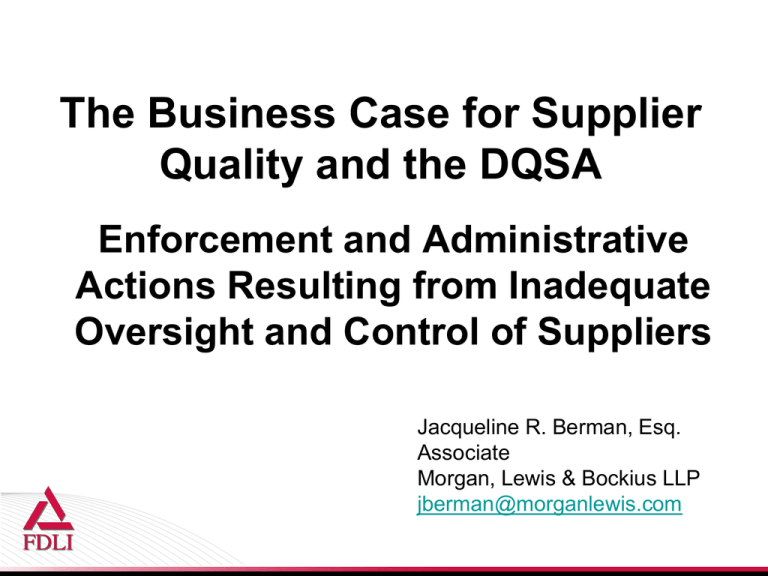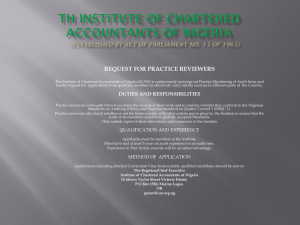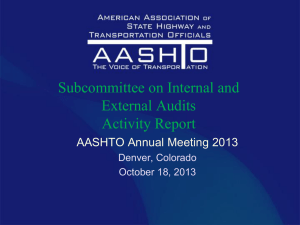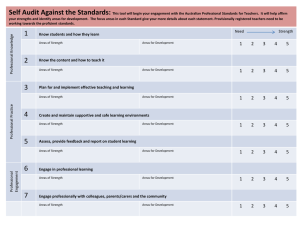
The Business Case for Supplier
Quality and the DQSA
Enforcement and Administrative
Actions Resulting from Inadequate
Oversight and Control of Suppliers
Jacqueline R. Berman, Esq.
Associate
Morgan, Lewis & Bockius LLP
jberman@morganlewis.com
Supplier Quality
Obligations and Why You Should
Care
3
Current Legal Landscape
• Current Good Manufacturing Practices
– FFDCA § 501
• Automatic adulteration if fail to comply with cGMPs
• Implementation of oversight and controls over
manufacturing
– Selected Regulations
• 21 C.F.R. § 200.10(b) (Contract manufacturers an
extension of manufacturer’s own facility)
• 21 C.F.R. § 211.22 (Quality unit ultimate authority for
product quality)
• 21 C.F.R. § 211.84 (Incoming inspection and testing)
• 21 C.F.R. § 211.184 (Component records)
4
Potential Regulatory Consequences of
Poor Supplier Quality Control
•
•
•
•
•
•
•
•
•
Adverse Inspectional Findings
Warning Letters
Product Recalls
Cessation of Manufacturing
Seizure
Injunction
Criminal Actions
False Claims Act Actions
Government Contracting
5
Warning Letter Examples
• Greer Laboratories Inc. (4/21/2014)
– Failure to establish reliability of supplier’s certificate of
testing through validation
• Sanquin Plasma Products (8/29/2013)
– Failure to perform incoming testing on supplier
components
• Jabones Pardo S.A. (8/22/2013)
– Failure to perform incoming testing, failure to establish
reliability of supplier’s analyses, failure to conduct identity
test when relying on supplier analyses
6
New Focus on Data Integrity
• Trifarma S.p.A. (7/7/2014)
– Failure to maintain complete data
– Failure to prevent unauthorized access or change to
data/prevent data omission
• Tianjin Zhongan Pharmaceutical Co., Ltd
(6/10/2014)
– Failure to maintain appropriate documentation to record
manufacturing operations performed on individual pieces
of equipment
7
New Consequences of
Inadequate Supplier Controls
Inadequate supplier controls will
require additional product oversight
beginning January 2015
8
Selected DQSA Requirements
• Specifics will depend on role in the supply chain
• Some requirements more administrative/procedural
– Record keeping and information transfer
– Product identifier
– Authorized trading partners
• Other requirements related to supplier quality
– Suspect and illegitimate product identification,
investigation, quarantine, and notification
– Requests for information
– Returned products
9
Some DQSA Practical
Implications
• DQSA compliance obligations will substantially affect
contractual provisions in sales and related documents
– Current commercial terms likely affected
– New contracts for outsourced functions requiring supplier
controls
• New SOPs
• Training and Auditing
• Potential False Claims Act claims arising out of
certifications
10
Selecting and Working with
Third Parties
Lori F. Hirsch
Managing Counsel
Merck Sharp & Dohme Corp.
December 9, 2014
Why utilize Third Parties?
•
•
•
•
Need for specialized capabilities
Product lifecycle management
Market access
Cost optimization
Selecting a Mate
Things to consider before you
enter a Marriage
1. Don't marry the person you think you can live
with. Marry the one you can't live without!
2. Don't marry someone who has characteristics
that you feel are intolerable!
3. Do not marry impulsively!
4. Make sure that each partner has an iron-willed
determination to make it work!
Effective Due Diligence is
Essential!
• Qualifications – does the third party have the ability to do what you
need them to do?
• Experience – does the third party have the right experience to do
what you need them to do?
• Expectations – have you clearly defined what the third party will do,
including expectations, standards, etc.
• Compliance – does the third party understand cGMPs and have
appropriate systems, processes and people?
• Capacity – does the third party have available capacity?
• Culture – does the culture at the third party match your company’s
culture?
• Determination – are you both determined to make this relationship
work?
Some Due Diligence Areas
• Manufacturing capabilities - facilities, processes, systems and
people
• Management team who are experienced and competent, including
quality personnel
• Communication skills
• Regulatory agency experience and history
• Understanding of Quality System/GMP requirements
• Willingness to provide access to the manufacturing site, as needed,
including management visits and audits.
Realities of Working with
a Third Party
• A company retains accountability for the acts or
omissions of the third party.
– Despite the fact that control has been surrendered to the third
party
– Only the third party has the direct access to the contracted
activity.
• A company has limited monitoring and influence.
– Critical to select the right third party.
Commercial Agreement
• The “what”
• Contract must be clear as to roles, responsibilities and
obligations.
– Remember: terms will often be interpreted, several
years later, by people not party to the original
negotiations.
– Consider cultural and language differences.
• Terms should be explicit, where possible.
• Dispute resolution/escalation defined.
• Process for changes should be defined.
Quality Agreement
• The “How”
• The Quality Agreement should be standalone.
– Allows the quality provisions to be changed from time to time
without opening the entire agreement.
• Should include such things as:
– Rights to visit during manufacturing of Companies’ products,
audits, etc.
– Requirements for prior approval of any changes to the third
party’s facility, equipment, materials or components
– Notification of any out-of-specification (OOS) test results and
stability failures
– The ability to evaluate any deviations and/or investigations as
well as the review of manufacturing batch records
– Recall decisions and regulatory notifications.
And, the marriage begins . . .
Are you ready to manage the
relationship?
• Do you have the right people with the right
skills to manage these third party
relationships in a way that ensures patient
safety and security of supply?
– Increasingly, these relationships are the
subject of regulatory scrutiny.
On-going oversight
•
•
•
•
•
Meeting Company’s expectations
Oversight of manufacturing processes
Site visits
Performance/Quality Metrics
Periodic Review of Manufacturing and
Quality records, including test data
• Escalation Process for managing supplier
deviations
Goal
Calibrated Quality Oversight Model
• Introduce risk-based management to the Third Party
Quality Oversight Process
Drivers
– Define process for determining level of Quality oversight
• Recognize and leverage the development, operational
and compliance capabilities of Third Parties
• Objective assessment that drives consistent
management of Third Parties
• Assessment consistency across the life cycle of the
Third Party relationship (identify, select, manage)
23
Quality Oversight Business Process
Qualification/
Quality
Agreement
Monitoring
Quality
Oversight
Calibrated
Oversight
QA/QC
Calibrated Quality Oversight Model
Process
– Determine appropriate level of oversight based on:
•
•
•
•
•
•
Quality Systems implementation
Contracted activity (e.g. API vs. sterile pharmaceutical)
Technology ownership and complexity
Historical experience / knowledge of third party
Performance (metrics, relationship)
Compliance performance / history
– Process Utilizes Assessment Tool
• Defined criteria consistently applied
• Information repository for ongoing assessment
– Results in Recommendation Memo
– Ongoing Assessment
25
Assessment Design
Strategic Quality Risk
Management Model requires
assessment of risk for …
– FDA Six Systems (30 Subsystems)
•
•
•
•
•
•
Quality Management
Facilities & Equipment
Materials
Production
Packaging & Labeling
Laboratory Control
– Two additional assessment
elements
• Technology Complexity &
Ownership
• Compliance
To provide the users with
guidance on . . .
– Degree of presence in the third
party’s facility.
– Responsibility for control of
starting materials.
– Level of review/oversight on
planned and unplanned
(deviations) changes.
– Level of review of batch
documents.
– Responsibility for product testing.
– Responsibility for release of
product for “further processing.”
Quality Oversight Levels
RISK
ASSESSMENT
LEVEL
PRODUCT
TESTING
OPERATIONS
RAW
MATERIALS
DEVIATION
MANAGEMENT
PRODUCT
RELEASE
HIGH
All testing by
Company– third
party is not
eligible for
inclusion in the
reduced testing
program
Full time
presence of
Company
overseeing third
party operations
Materials
supplied and
cleared by
Company
All deviations/
changes reviewed
and approved by
Company
Release by
Company
MEDIUM
All testing by
receiving sites.
Third party is not
eligible for
inclusion in the
reduced testing
program
Companies’
personnel only
present at critical
stages (e.g.
validations)
Company
specifies sources
but third party
may clear for use
Only designated
changes (listed in
Quality Agreement
appendix) are
approved by
Company and
deviations are
reviewed by
Company
Release by
Company
LOW
Third party is
eligible for
inclusion in the
reduced testing
program
No Company
presence other
than routine
audits and visits
Materials
sourced and
controlled by
third party
unless otherwise
specified in the
Quality
Agreement
Company reviews
deviations and
changes as defined in
the Quality
Agreement
Release by
Company
Questions
Current Challenges with Data
Integrity and Managing Suppliers
A Changing, Global Environment
©2014 Lachman Consultant Services, Inc. All rights reserved.
Roy Sturgeon
President
Lachman Consultants
Westbury, NY 11590
F.Zipp@lachmanconsultants.com
Legal Notice
The information displayed on these presentation slides is for the
sole private use of the attendees of the seminar at which these
slides were presented. Lachman Consultant Services, Inc.
(“Lachman Consultants”) makes no representations or warranties
of any kind, either express or implied, with respect to the
contents and information presented. All original contents, as well
as the compilation, collection, arrangement and assembly of
information provided on these presentation slides, including but
not limited to the analysis and examination of information herein,
are the exclusive property of Lachman Consultants protected
under copyright and other intellectual property laws. These
presentation slides and the content and information contained
herein may not be displayed, distributed, reproduced, modified,
transmitted, used or reused, without the express written
permission of Lachman Consultants.
31
Agenda
Supplier Quality Management Process
Data Integrity and 21 CFR Part 211
Potential Regulatory Consequences
Laboratory Audit Methodology
Proactive Action Plan
32
Has Something Changed?
Increased Use of
CMOs, Globally
Requires Proactive
Management of
CMOs
33
Audits
Communication/ Management
Notification
Performance Metrics/Trend
Evaluation
Quality Agreements
Global
cGxP
Compliance
Supplier Qualification
Supplier Quality Management
ICH Q8, Q9, Q10
Global IT Systems
Conformance to Applications
Detection Prevention
34
Critical Success Factor-Supplier Quality
Management-Data Integrity Detection
35
Integrity
A Hierarchy of Drivers. Digital image. Web. 24 Nov. 2014. <http://thebestbrew.files.wordpress.com/2009/06/hierarchyofdrivers_small.jpg>.
36
GMP Regulatory Requirements for Data
Integrity Per 21CFR 211
Instruments must be qualified and fit for purpose [§211.160(b), §211.63]
Software must be validated [§211.63]
Any calculations used must be verified [§211.68(b)]
Data generated in an analysis must be backed up [§211.68(b)]
Reagents and reference solutions are prepared correctly with appropriate records
[§211.194(c)]
Methods used must be documented and approved [§211.160(a)]
Methods must be verified under actual conditions of use [§211.194(a)(2)]
Data generated and transformed must meet the criterion of scientific soundness
[§211.160(a)]
Test data must be accurate and complete and follow procedures [§211.194(a)]
Data and the reportable value must be checked by a second individual to ensure
accuracy, completeness and conformance with procedures [§211.194(a)(8)]
37
Potential Regulatory Consequences of Fraud
Stop Production/Distribution … some or all products based on nature of evidence
and results of ongoing District and Company/3rd-party audits
“Voluntary” Recall (Class II) of affected products
Downgrade Therapeutic Equivalence Rating … promptly changed the
product’s therapeutic equivalence rating to “not equivalent”, thereby becoming noninterchangeable and without a market
Withdraw ANDA Approval … initiated administrative proceedings to withdraw
ANDA approval … unless “voluntarily” withdrawn
Suspension of Future Approvals … OGD continued review of pending ANDAs,
supplements and annual reports for products not directly implicated; however, final approval
withheld based on general integrity concerns (“Alert List”)
Application Integrity Policy … CDER Director notifies company that all NDA/ANDA
reviews have been suspended pending the company’s compliance with the conditions of the
AIP
38
What to Look for When Assessing Suppliers?
Fraud - The Big Three:
Altered Data
Overwriting of data in chromatography data systems
Manipulation of integrations to achieve a passing result
Omitted Data
Selective reporting of data for release decisions
Undocumented Sample Trial Injections
Manufactured Data
Creation of replacement or dummy weight tapes
39
Audit Methodology
Use the element of surprise:
• Visit laboratory areas as soon as possible and unannounced if
possible.
• Spend the majority of the audit time in the laboratory before
conducting the more methodical lab systems audit (SOP reviews
etc.)
• Shift direction of coverage at times when possible rather than
following the sequence of unit operations.
• Target for review difficult or complex methods and systems in the
lab, and those associated with deviations, OOS investigations,
complaints, FARs, etc.
• As each area in the lab is examined, interview an analyst and/or
supervisor. The purpose is to look for evidence of improper data
handling, documentation and other practices, and whether the
analyst/supervisor have adequate understanding of relevant GMP
practices.
40
Audit Methodology (Cont’d)
As soon as possible, visit the laboratory (or other target area) to
observe operations and identify targets of interest for immediate
evaluation.
Areas that should be targeted include
Raw data vs. reports vs. sample/instrument logs vs. other forms of
secondary documentation
Identification and control of samples, aliquots, and standards
Contemporaneous entries versus delayed or back-dating
Condition and control of instrumentation;
Suitability of the lab environment;
Applicable Part 11 requirements; and
Rigor of QC/QA independent data review procedures and practices
41
Audit Methodology:
Computer Systems & Electronic Records
Determine if standalone and networked systems are subject to
Part 11 controls. Initially, target standalone instruments to
determine nature of testing performed and data being stored,
potential for overwriting data, backup practices, audit trails,
access privileges, password protection, data review practices,
etc.
For standalone systems, check
Nature of data stored and, who has access, how the system is
being used
If any application programs reside on the system, such as Word,
Access or Excel, and if so, check for unauthorized storage of data,
reports, production or test records, SOPs, etc. If these programs
exist, ask the user to log onto the system and open document
folders
42
Audit Methodology:
Computer Systems & Electronic Records (cont’d)
Check procedures for granting user privileges and whether
approvals are documented.
Check whether privileges are updated when employees change
position or terminate their employment.
Check on use of individual Passwords, User IDs, Electronic
Signatures, and verify they are not being shared.
Check on frequency of system back-ups, whether at
appropriate intervals (e.g., immediate, daily).
43
Audit Methodology:
Computer Systems & Electronic Records (cont’d)
Ask users to log onto networked and standalone systems, and
check audit trail functions
Verify that the audit trail function cannot be overridden or turned off.
Determine if electronic data can be modified, overwritten or
deleted from network or standalone systems.
Determine if QC or other units have the ability to modify or delete data.
Determine the role of the IT coordinator in managing electronic data.
Determine who has the ability to make changes to
hardware/software configurations in standalone and
networked systems and whether changes are being
documented and approved in accordance with change control
procedures, and are appropriately validated.
44
Audit Methodology:
Lab Documentation Practices
Review documents, logs and records on lab benches, desktops, shelves,
etc., especially those that are in use, to determine if entries appear to be
complete, contemporaneous and, where possible, consistent with
instrument outputs and settings.
Carefully examine laboratory balance weight tapes. Are all tapes and type
on tapes the same or similar color? For a particular set of related
weighings, are the elapsed times even possible (Six weight determinations
on an analytical balance in 60 seconds.)? Are the weights recorded “too
good to be true” (four weight determinations exactly the same in 60 – 120
second time period)?
Open drawers, lockers and physical folders to look for test reports, raw
data, obsolete SOPs and test methods, and handwritten entries on docs
indicative of not directly entering data into official records (e.g., instrument
parameters; weights; results; etc.)
45
Audit Methodology:
Lab Documentation Practices (cont’d)
Examine waste containers to determine whether contents
include original data, instrument output, test records, test
reports, etc.
Determine where documents intended for shredding are
stored; examine documents that are pending shredding. There
should be no routine access to paper shredders in the
laboratory.
Observe from a distance whether analysts and supervisors
appear to be making contemporaneous entries into records.
46
Audit Methodology:
Sample Custody
Look for samples in drawers, lockers, refrigerators and other
locations where storage of samples is unexpected.
Look for samples, aliquots and vials that are not adequately
labeled.
Open refrigerators and freezers to evaluate conditions,
settings, samples, vials, etc., and look for inadequate sample
identification and/or storage conditions.
Test and stability sample reconciliation.
47
Audit Methodology:
Training Program
Review overall adequacy of the training program (e.g., individual
employee training records, curricula, training schedules, course
content, assessments).
Check training records of individual employees who are associated
with manufacturing deviations, and with deficiencies identified during
the course of the audit.
Check training program and training records for temporary/contract
employees.
Review training programs and records of employee training related
to computer security (e.g., Part 11 requirements, password use, user
access, record retention, change control, use of PCs/standalone
computers).
Review the training program and procedures for Good
Documentation Practices to determine if the issues of Authenticity
and Falsification data are adequately and forcefully addressed.
48
Audit Methodology:
Data Integrity Audit Interviews
Examples of Interview Questions:
What is this record, and what is being entered?
What is the source of the information that is being entered?
When and How was the information determined?
How soon after the information is determined are the entries made?
What source documentation or instrument outputs support these
entries?
How do you become aware of missing or mistaken entries after the
fact?
How do you correct missing or mistaken entries?
What are the applicable procedures for preparing this documentation?
Are the procedures clear and consistent with actual practice?
Have you been trained on the current procedures?
Do you and the other analysts use the same practices?
Is there anything else you would like to explain?
49
Points to Consider
When Evaluating Data Integrity Findings
What systems are deficient or require improvement in the
findings presented in the following section?
Is the finding a case of Data Integrity or bad Laboratory
practices/GMP non-compliance? Or both?
What is the potential impact of the finding?
If incidence of GMP compliance, how could it potentially
impact the integrity of the data?
For each finding, what action might be taken?
50
Preparation of Proactive Action Plan
Based on the information presented, it should be possible to
prepare a proactive Action Plan for Data Integrity
Action Plan starts with an outline of planned activities by
system, especially in the laboratory
Identification of lab systems requiring enhancements can be
identified by auditing the high risk areas discussed today.
• Most difficult area to audit is the identification of trial injections, if any.
Typically, this requires a focused dedicated forensic assessment of
chromatography data systems and audit trails.
51
Preparation of Proactive Action Plan
(Cont’d)
Plan would take the form of System by System listing of areas
(using the laboratory as an example), including but not limited
to:
•
•
•
•
•
Chromatography Data Systems – Security & Controls
Standalone Instruments
Balance Usage
Sample custody and reconciliation
Chromatographic Data – Trial Injections
For each system the gaps identified by the recommended
assessment and the associated action steps to address the
gaps should be documented, along with the resources
assigned to corrective and preventative actions.
52
Thank You!
Frances M. Zipp
President
Westbury, NY 11590
516-222-6222
Email:F.Zipp@LachmanConsultant
s.com
www.LachmanConsultants.com
53









